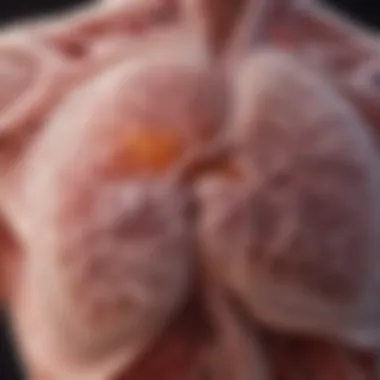Pleural Plaques and COPD: Understanding the Link


Intro
Chronic obstructive pulmonary disease (COPD) is a significant global health concern that affects millions of individuals worldwide. Understanding the risk factors associated with COPD is essential for prevention and treatment. One area of growing interest is the relationship between pleural plaques and the development or aggravation of COPD symptoms. Pleural plaques are areas of fibrous tissue that can develop on the pleura, the thin membrane lining the chest cavity and lungs. Recognizing whether pleural plaques contribute to lung health complications like COPD can help healthcare professionals in diagnostics and management strategies.
Key Findings
Major Results
Current research suggests a notable association between pleural plaques and increased respiratory issues. While pleural plaques themselves may not directly cause COPD, their presence in individuals often correlates with a history of asbestos exposure, which is a known risk factor for COPD. Evidence indicates that patients with pleural plaques may experience worse lung function and symptoms compared to those without such plaques.
Discussion of Findings
The investigation into the connection between pleural plaques and COPD highlights several crucial points:
- Asbestos Exposure: Many individuals with pleural plaques have a history of asbestos exposure, linking the condition to potentially hazardous environments.
- Lung Function Impairment: Research has shown that pleural plaques can be associated with lung function decline over time.
- Increased Symptoms: Individuals with pleural plaques are likely to report increased respiratory symptoms, such as chronic cough and shortness of breath.
This suggests that while pleural plaques alone may not qualify as a definitive cause of COPD, they could serve as indicators of underlying lung damage that may lead to or worsen COPD symptoms.
Methodology
Research Design
To explore the relationship between pleural plaques and COPD, researchers often utilize longitudinal studies that track patient outcomes over time. This design allows for the assessment of long-term impacts and complications associated with pleural plaques.
Data Collection Methods
Data is typically gathered through various methods:
- Medical Imaging: Chest radiographs and CT scans are commonly used to diagnose pleural plaques and assess lung condition.
- Patient Surveys: Questionnaires evaluating respiratory symptoms and medical history contribute valuable information to researchers.
- Pulmonary Function Tests: These tests measure lung capacity and function, providing insight into the severity of potential COPD.
The combination of these approaches creates a comprehensive understanding of how pleural plaques may affect lung health over time.
Understanding Pleural Plaques
Understanding pleural plaques is essential in the context of this article for multiple reasons. First, they provide insights into some of the underlying mechanisms that may relate to chronic obstructive pulmonary disease (COPD). By grasping what pleural plaques are, one can begin to appreciate their potential implications for lung health and disease progression. Furthermore, recognizing the characteristics and causes of pleural plaques adds depth to the discussion regarding risk factors associated with COPD. This segment not only enhances comprehension of pleural plaques themselves but also sets the stage for exploring their relationships with respiratory diseases.
Definition and Characteristics
Pleural plaques are localized, fibrous thickenings on the pleura, which is a double-layered membrane surrounding the lungs. They are often asymptomatic and discovered incidentally during imaging studies. The plaques vary in shape and size, commonly appearing as white, irregular patches on the pleural surface. They are most frequently associated with exposure to asbestos but can also result from other environmental exposures. Notably, pleural plaques do not progress to cancer, which distinguishes them from other pleural diseases. Their presence indicates a prior exposure to harmful agents, warranting further investigation into respiratory health.
Causes of Pleural Plaques
The development of pleural plaques can be attributed to several factors. Understanding these causes is crucial for preventing their occurrence and managing associated health risks.
Exposure to Asbestos
Exposure to asbestos is the primary cause of pleural plaques. Asbestos fibers are very durable and can remain in the lungs for long periods. Once inhaled, they irritate the pleural linings, leading to scar tissue formation, which manifests as plaques. This link is significant because it emphasizes the need for strict regulations regarding asbestos use and management in occupational settings. The unique feature of asbestos exposure is its historical prevalence in various industries, which means that many individuals are unknowingly at risk even today.
Occupational Risks
Occupational risks play a crucial role in the development of pleural plaques. Jobs that expose individuals to asbestos or other respiratory irritants are of primary concern. Industries such as construction, shipbuilding, and automotive repair have historically posed higher risks. The key characteristic of this causative factor is its cumulative nature; prolonged exposure increases the likelihood of developing pleural plaques. Moreover, individuals working in these environments must remain vigilant about health screenings to catch any early signs of related conditions.
Environmental Factors
Environmental factors also contribute to the formation of pleural plaques. While asbestos is a significant factor, other irritants in the air, such as pollutants, can aggravate the pleura and lead to changes. For instance, exposure to certain chemicals or dust can cause inflammation, similar to that caused by asbestos. The notable feature of environmental factors is their often insidious nature, as many victims may be unaware of their exposure until symptoms arise. Addressing these factors is essential for public health advocacy, emphasizing the need for cleaner air and better environmental protections.
Pathophysiology of Pleural Plaques
The pathophysiology of pleural plaques involves several processes that lead to their development and the subsequent changes in lung structure. Insight into these mechanisms aids in understanding their potential impact on respiratory health.
Development and Formation
The development of pleural plaques starts with the inhalation of asbestos or irritant particles. These particles elicit an inflammatory response in the pleura, which leads to the deposition of collagen fibers over time. This process marks the transition from initial exposure to visible plaques. The benefit of understanding this developmental pathway lies in the opportunity to intervene early, potentially preventing the progression of respiratory diseases.


Histological Changes
Histological changes are critical in assessing pleural plaques' impact on lung health. Under microscopic examination, pleural plaques show dense collagen deposition and altered cellular architecture. These changes indicate a reactive process that could impair lung function. Recognizing these histological features allows for better interpretation of imaging results and a more precise assessment of related diseases, particularly COPD. The importance of identifying these changes cannot be overstated, as they could inform future therapeutic strategies.
Chronic Obstructive Pulmonary Disease Overview
Chronic Obstructive Pulmonary Disease (COPD) plays a crucial role in understanding the relationship between lung health and pleural plaques. This section outlines the fundamental aspects of COPD, which is not only a significant public health concern but also has underpinnings that may intersect with the pathophysiology of pleural plaques. Understanding the characteristics, symptoms, and epidemiology of COPD is essential for assessing how these two entities might interact over time.
Definition and Classification
COPD is defined as a group of progressive lung diseases that cause breathing difficulties. It encompasses conditions such as emphysema and chronic bronchitis, characterized by airflow limitation that is not fully reversible. The Global Initiative for Chronic Obstructive Lung Disease (GOLD) provides a classification system based on the severity of symptoms and airflow limitation, ranging from mild (Stage 1) to very severe (Stage 4), which helps healthcare providers in developing effective management plans for patients.
Symptoms and Diagnosis
Common Clinical Presentations
The common clinical presentations of COPD include chronic cough, sputum production, wheezing, and shortness of breath. Recognizing these symptoms is essential for early diagnosis and intervention. The chronic nature of these symptoms often leads patients to ignore or normalize them, which can delay medical action.
An important aspect of these presentations is their variability; symptoms can fluctuate based on environmental factors or the presence of infections. This variability contributes to the complexity in patient management, highlighting the need for tailored approaches.
Diagnostic Tools and Techniques
The diagnosis of COPD is typically confirmed through a combination of clinical evaluations and diagnostic tests. Spirometry is a key tool; it measures the amount of air flow and helps classify the severity of airflow obstruction. Furthermore, imaging techniques like chest X-rays and CT scans can aid in assessing structural changes in the lungs.
The unique feature of spirometry is its ability to provide objective data regarding lung function. However, its dependence on patient cooperation can sometimes lead to inaccurate results. Therefore, clinicians often consider additional criteria and tests for a comprehensive diagnosis.
Epidemiology of COPD
Global Prevalence
COPD is one of the leading causes of morbidity and mortality worldwide. Its global prevalence varies significantly based on geographic regions, lifestyle factors, and access to healthcare. According to the World Health Organization (WHO), an estimated 251 million people were affected by COPD in 2016.
This staggering figure underscores the importance of awareness and education regarding COPD as it contributes significantly to healthcare burdens across nations.
Risk Factors
Understanding the risk factors for COPD is essential in addressing and managing the disease. Major risk factors include cigarette smoking, exposure to air pollutants, occupational exposures, and genetic factors such as alpha-1 antitrypsin deficiency.
Reducing these risk factors presents a strategic avenue for prevention and management. The multifaceted nature of these risk factors can complicate the epidemiological landscape of COPD, as they may overlap with other respiratory conditions, including those associated with pleural plaques.
Investigating the Connection Between Pleural Plaques and COPD
Understanding the connection between pleural plaques and chronic obstructive pulmonary disease (COPD) is crucial for both clinical and research communities. This section will explore how pleural plaques, a well-documented consequence of asbestos exposure, may relate to COPD, an ailment that significantly affects respiratory function. The investigation of this connection holds the potential to deepen our understanding of lung conditions and improve patient management strategies.
Existing Research Studies
Findings Supporting a Link
Research has shown a possible connection between pleural plaques and COPD symptoms. Some studies suggest that individuals with pleural plaques exhibit a greater decline in lung function compared to those without them. This section emphasizes the epidemiological evidence supporting this link. A key characteristic of these findings is the prevalent observation of reduced forced expiratory volume in one second (FEV1) among patients with pleural plaques. Its relevance lies in the ability to recognize a potential risk factor for COPD exacerbation in these patients.
The unique feature of these findings is the cross-sectional studies that document lung function measurements alongside imaging results. These studies provide insight into how pleural plaques may impact overall lung health. However, the correlation remains complex, and determining causation from correlation is an ongoing issue.
Contradictory Evidence
While some research supports a link between pleural plaques and COPD, other studies indicate no significant relationship. This contradictory evidence adds depth to the discussion about the impact of pleural plaques on lung health. A crucial aspect of these studies stems from the heterogeneity within patient populations. Different biosocial factors, such as smoking history and comorbidities, could skew results and complicate conclusions.
These contradictory findings present an opportunity for further investigation, highlighting the unique feature of variability in individual responses to asbestos exposure. Understanding these factors may justify why some individuals with pleural plaques do not exhibit significant respiratory issues. The limitations of these studies often appear in the form of small sample sizes and lack of long-term follow-up, which can hinder the generalizability of results.
Mechanisms of Interaction
Inflammation and Lung Function
The interaction mechanisms between pleural plaques and COPD may be rooted in inflammatory processes. Inflammation is a common denominator in respiratory diseases, and studies reveal that chronic inflammation can lead to lung function decline. A key characteristic of this aspect is the alteration of lung architecture due to inflammatory responses from pleural plaques. This is pertinent for understanding how persistent inflammation can exacerbate COPD.
One unique feature is the identification of biomarkers in the blood that correlate with lung inflammation. These biomarkers can potentially lead to better patient stratification and personalized management strategies. However, the advantage here lies side-by-side with the disadvantage of variability in individual inflammatory responses, making predictive models challenging.


Impact of Fibrosis
Fibrosis plays a significant role in understanding the impact of pleural plaques on lung function. The process of fibrotic changes can contribute to airway obstruction and decreased elasticity. A significant characteristic is the relationship between the extent of pleural plaques and pulmonary fibrosis. Research indicates a correlation between the severity of pleural plaques and diminished lung capacity. This correlation indicates that greater asbestos exposure can lead to more pronounced lung issues.
The unique aspect of studying fibrosis in this context is its dual nature as both a consequence and a cause of respiratory decline. While identifying fibrosis can inform treatment pathways, it may also mask nuances in individual patient presentations. This complexity calls for more nuanced diagnoses and considerations of pleural plaques' implications in clinical practice.
Clinical Observations and Case Studies
Clinical observations provide further insights into the relationship between pleural plaques and COPD. Frontline healthcare providers frequently report on the respiratory challenges faced by patients with pleural plaques, often sharing case studies that illustrate varying degrees of lung function impairment.
Such accounts can inform practitioners about symptom presentations and guide treatment approaches. Understanding how real-world patients experience this intersection of conditions enriches the emerging story around pleural plaques and COPD, laying the groundwork for future studies and innovative clinical methodologies.
Diagnosis of Pleural Plaques and COPD
The diagnosis of pleural plaques and chronic obstructive pulmonary disease (COPD) plays a critical role in understanding how these two conditions might interrelate. Accurate diagnosis can lead to better management of symptoms, improved patient outcomes, and the prevention of further lung damage. Given that COPD is a common ailment with potentially serious implications, identifying pleural plaques as a contributing factor is essential in comprehensively addressing a patient’s lung health.
When assessing for pleural plaques, healthcare providers rely on various diagnostic tools. These tools not only help to confirm the existence of pleural plaques but also determine their extent and any impact they may have on lung function.
Radiological Imaging Techniques
CT Scans
CT scans serve as a major component in the diagnosis of pleural plaques. Their efficacy lies in their ability to provide detailed cross-sectional images of the chest. This imaging technique allows for the identification of pleural thickening, calcification, and other changes that may indicate the presence of plaques. One key characteristic of CT scans is the high resolution of images they produce, which aids physicians in differentiating between benign plaques and more concerning pathological changes.
However, CT scans also come with some drawbacks. The exposure to radiation, while considered safe, is a factor to consider, especially in patients requiring multiple scans over time. Furthermore, while CT scans are excellent for visualizing structural changes, they may not provide a full evaluation of lung function.
X-Rays
X-rays represent another critical tool in the diagnosis process. They are often the first line imaging study performed for patients showing respiratory symptoms. X-rays can reveal prominent pleural plaques but may not detail the extent or specific characteristics of these lesions. A key characteristic of X-rays is their quick execution and relatively low cost, making them a popular choice in many clinical settings.
Nonetheless, X-rays have limitations compared to CT scans. Their resolution is not as high, so smaller plaques or subtle changes may be missed. Also, X-rays provide a two-dimensional view, which might create challenges in visualizing the three-dimensional structure of the pleura.
Pulmonary Function Tests
Pulmonary function tests are an essential aspect of diagnosing COPD. These tests measure how well the lungs are working and can help determine the extent of any obstruction present. They typically include spirometry, which assesses airflow and can reveal patterns of lung function impairment. Identifying changes in lung function is crucial, as they may correlate with the presence of pleural plaques and overall chronic lung disease.
In summary, through various imaging techniques and functional assessments, diagnosing pleural plaques and COPD provides valuable insights into a patient’s respiratory health. Understanding the interactions between these conditions can facilitate more tailored treatment plans, ultimately enhancing quality of life for affected individuals.
Management of Pleural Plaques and COPD
Management of pleural plaques and chronic obstructive pulmonary disease (COPD) involves understanding and addressing each condition's unique aspects. This section aims to clarify how both conditions can interact and influence treatment approaches. Effective management can lead to improved quality of life for patients by minimizing symptoms and optimizing lung function.
Treatment Options for COPD
Medication and Therapy
Medication and therapy serve as the cornerstone of COPD management. This aspect primarily includes bronchodilators and corticosteroids. These medications work by relaxing the airways and reducing inflammation, which can make breathing easier for patients. The key characteristic of these treatments is their ability to target the symptoms of COPD effectively.
Advantages: They can lead to significant improvements in lung function and overall health. The introduction of newer therapies, like combination inhalers, has made it easier for patients to manage their conditions.
Disadvantages: However, these options may come with side effects. Long-term use of corticosteroids, for instance, can increase the risk of infections and osteoporosis. Therefore, careful monitoring and personalized treatment plans are essential.
Lifestyle Modifications
Lifestyle modifications play a pivotal role in the management of COPD. This includes smoking cessation, exercise, and dietary changes. These aspects are beneficial as they can significantly enhance a patient's lung health and overall well-being.
Key Characteristics: Notably, smoking cessation is the most critical change a patient can make. It directly impacts the progression of COPD and overall lung function.
Unique Features: Exercise programs tailored for individuals with COPD can also strengthen respiratory muscles and improve endurance.
Advantages: The benefits of lifestyle modifications extend beyond lung health—they improve mental health and social interactions, thus enriching a patient's quality of life.
Disadvantages: Although they are essential, these modifications require commitment and consistency from individuals, which can sometimes be challenging.


Impact of Pleural Plaques on Treatment
The presence of pleural plaques can complicate the management of COPD. The interaction between these two conditions can influence treatment strategies and patient outcomes. For instance, individuals with pleural plaques may exhibit increased pulmonary fibrosis, which can exacerbate COPD symptoms.
Monitoring becomes more critical in such cases. The presence of these plaques may signal previous asbestos exposure, leading caregivers to implement tailored therapeutic options and monitoring protocols, focusing specifically on patients’ comprehensive lung health.
"Understanding the implications of pleural plaques can guide the therapeutic approach, ensuring that patients receive optimal care."
Preventative Measures
Preventative measures play a critical role in managing the relationship between pleural plaques and chronic obstructive pulmonary disease (COPD). By targeting the sources of pleural plaque formation and fostering general lung health, individuals can potentially reduce the risk of developing COPD or minimize its impact. Emphasizing prevention helps to address both environmental and lifestyle factors that can contribute to lung disease.
Reducing Asbestos Exposure
Asbestos exposure is one of the primary causes of pleural plaques. Therefore, reducing exposure is crucial in preventing the formation of these plaques and subsequent lung health issues. Key strategies to minimize asbestos exposure include:
- Awareness: Understanding where asbestos can be found is vital. Older buildings, roofing materials, and certain insulation products may contain asbestos. Simple measures like checking for these before renovations can be helpful.
- Professional Assessment: If asbestos is suspected, hire professionals trained in asbestos management. They can safely assess and remove the material.
- Regulatory Compliance: Abide by national and local regulations regarding asbestos handling and removal. Following these guidelines ensures that exposure risks are minimized in various settings.
- Occupational Safety: Those who work in industries where asbestos exposure is likely should use personal protective equipment (PPE). Employers must provide training and safety measures to protect workers from inhalation risks.
By taking these actions, individuals can significantly cut down their risk of developing pleural plaques and related respiratory diseases.
General Lung Health Strategies
In addition to focusing on reducing asbestos exposure, maintaining general lung health is important. Key strategies for enhancing lung health include:
- Avoiding Smoking: Smoking is a leading cause of COPD. Quitting smoking or never starting is one of the most effective ways to protect lung health.
- Regular Exercise: Engaging in physical activity can strengthen lung function. Aim for at least 150 minutes of moderate aerobic activity each week. This can help improve overall cardiovascular health, which is closely linked to lung function.
- Healthy Diet: A balanced diet rich in fruits, vegetables, and whole grains supports immune function and reduces inflammation. Nutrients such as antioxidants can be particularly beneficial for lung health.
- Staying Hydrated: Maintaining proper hydration helps keep the mucosal linings of the airways moist, thus promoting better lung function.
- Avoiding Pollutants: Minimize exposure to indoor and outdoor air pollution by using air purifiers and ensuring good ventilation in living spaces.
These strategies not only promote lung health but also empower individuals to take proactive steps toward protecting their overall well-being.
"Adopting preventative measures can greatly impact both COPD and pleural plaques, leading to healthier lives."
Future Research Directions
Research on the connection between pleural plaques and chronic obstructive pulmonary disease (COPD) is vital for several reasons. Understanding how these two conditions interact can lead to better outcomes for patients. The implications far exceed mere academic interest; they pave the way for improved diagnostic processes and targeted treatment strategies that can potentially change patient experiences dramatically.
Identifying the specific areas that need further exploration is imperative. New studies can unearth the biological mechanisms by which pleural plaques may influence the severity of COPD. It may also provide insights into whether early identification of pleural plaques could serve as an indicator for the development of COPD in at-risk populations. Hence, investigating these connections is a necessary progression in both respiratory medicine and public health.
Unexplored Areas in the Connection
Several unexplored areas relate to the relationship between pleural plaques and COPD. First, the long-term outcomes for patients with both conditions remain under-studied. We currently lack robust longitudinal studies that can track the progression of lung function in patients with pleural plaques over the years. More in-depth research can evaluate how the presence of pleural plaques influences the timeline and severity of COPD symptoms.
Second, the genetic predisposition in individuals with pleural plaques is another area for inquiry. Understanding whether certain genetic markers make individuals more susceptible to developing COPD could lead to enhanced screening techniques and tailored preventive measures. Additionally, the role of inflammation and its interaction with pleural plaques in exacerbating COPD symptoms is a subject worthy of exploration. More research could clarify the molecular pathways involved and help in developing precise interventions.
Potential Therapeutic Targets
Finding potential therapeutic targets is crucial for addressing the impact of pleural plaques on COPD. One promising area involves anti-inflammatory treatments that can potentially reduce lung inflammation associated with COPD exacerbations. If pleural plaques contribute to chronic inflammation, treatments aiming at inflammation control may play a dual role in managing both conditions.
Furthermore, the development of pharmacological options targeting fibrosis—another possible consequence of pleural plaques—should not be overlooked. Current antifibrotic therapies, such as nintedanib, have shown promise in conditions like idiopathic pulmonary fibrosis. Investigating its efficacy for individuals with COPD and pleural plaques could present an innovative pathway for management. In summary, further research into these potential targets could offer new hope for people suffering from the complications tied to both pleural plaques and COPD.
Epilogue
The conclusion serves a critical role in reinforcing the significance of the relationship between pleural plaques and chronic obstructive pulmonary disease (COPD). It encapsulates the essentials discussed throughout the article, offering a final perspective on key findings and implications that affect both medical practice and patient outcomes.
One of the main points is the increasing evidence suggesting a potential connection between pleural plaques and COPD. This relationship could indicate that individuals with pleural plaques are at a higher risk of developing or worsening COPD symptoms. Understanding this correlation is vital for healthcare providers. It enables early identification of at-risk populations and fosters tailored approaches to treatment and monitoring strategies.
Summary of Key Findings
The analysis presented highlights several important findings:
- Existence of Correlation: Research indicates a noteworthy association between pleural plaques and the exacerbation of COPD symptoms, particularly in patients with significant asbestos exposure.
- Mechanisms of Interaction: Inflammation and lung function impairment tied to pleural plaques can potentially lead to the progression of COPD.
- Risk Factors: Occupational and environmental exposures remain critical elements, suggesting that targeted prevention strategies should be prioritized for at-risk groups.
This synthesis provides a nuanced understanding that will inform future research and clinical protocols.
Implications for Patients and Providers
The implications are far-reaching for both patients and healthcare professionals. For patients, awareness of the link between pleural plaques and COPD can lead to more proactive health management. Strategies for monitoring lung health can be prioritized, enhancing overall outcomes.
For providers, integrating knowledge about this relationship into clinical practice is essential. This includes:
- Enhanced Screening: Increased vigilance during routine assessments for patients with a known history of asbestos exposure may be crucial.
- Tailored Treatments: Treatment plans should be cognizant of potential respiratory complications due to pleural plaques while managing COPD.
- Educational Resources: Offering patient education on the risks associated with pleural plaques and preventive health measures can empower individuals, fostering a collaborative approach to lung health.
Understanding the relationship between pleural plaques and COPD not only illuminates risks but also underlines the importance of comprehensive healthcare strategies.



